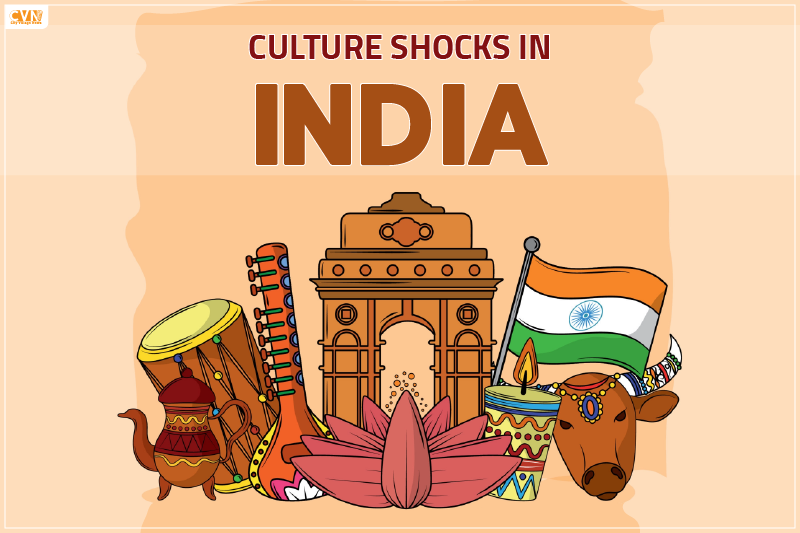India is a land of incredible diversity, with a rich history and a vibrant culture, unlike any other country in the world. From the bustling streets of Mumbai to the peaceful countryside of Kerala, India is a country that is full of surprises and unique experiences. However, for those who are new to the country, it can also be a place of culture shock. In this blog, let’s explore some of the most common culture shocks in India and provide tips on how to cope with them.
What is culture shock?
Culture shock refers to the sensations of disorientation and confusion that might arise when visiting a new nation or cultural context. Feeling homesick, being confused about customs and etiquette, and having difficulty engaging with locals are all symptoms of culture shock.
Culture shock is frequently connected with unpleasant emotions, yet it can also be a positive experience. Exposure to various cultures broadens people’s horizons and helps them to appreciate the beauty of diversity. Most people can adjust to their new surroundings and learn to appreciate the local culture with time and patience. Just like you show your patience while searching for the best site to book flight tickets. And we can help you find the same.
What are some common culture shocks in India?
The following are some examples of common culture shocks in India:
Food:
Foreigners are often surprised by how diversified and spicy Indian food can be.
Weather:
For the most part, the country has a tropical climate, which can be surprising to visitors who are used to cooler weather.
State of poverty:
Poverty and beggars abound in India, which can be alarming to people accustomed to better living circumstances.
People:
Because India is a densely populated country, streets, marketplaces, and public transportation can become jammed sometimes.
Disturbance:
Honking horns, traffic congestion, and overall chaos seem to rule the day in India. For newbies, this might be overwhelming.
The Clothes:
You may see a few men wearing long-skirts type of clothing, an Indian attire called “Dhoti.” It’s common in India.
Staring Men:
If you are busy roaming in the narrow lanes of India, you may notice a few men staring at you, it’s just because the dressing here is different from the Western world, and it may be the case that they are seeing your attire for the first time.
Vegetarian Food:
This is something very usual in India and you may see a variety of Vegetarian options as compared to non-vegetarian meals. This is because of the cultural beliefs in this country. India ranks as the first country with 42% of its population avoiding meat products.
Free Meals:
You may find various religious places carrying a community service of serving free meals to anyone who visits their premises. It is quite a common and highly respected gesture.
Squat toilet:
You may end up using squat toilets in some small hotels and restaurants. This concept is also common in India. You will also largely see Western toilets but without toilet paper and with the facility of water. So, carry your toilet paper while traveling.
There are many other shocks that the society and culture of india have but the above-mentioned are the most observed.
How to deal with culture shock?
Now, coming to the discussion, there are certain things you may do to make it easier if you are experiencing cultural shock:
- Keep in mind that everyone experiences culture shock at some point in their lives. It is typical, so don’t be too concerned.
- Try to be patient and open-minded. Expect nothing to be the same as it is at home and be open to new witness experiences.
- Reach out to those who are going through cultural shock. Share your experiences and concerns with them and ask for advice on how to deal with it.
- Don’t forget to look for yourself. Check to see if you’re getting enough sleep, food, and water.
- If you begin to feel overwhelmed, take a break from sightseeing and spend some time relaxing in your hotel room or walking through a park.
If you keep these things in mind, you’ll begin to feel more at ease in your new surroundings. Culture shock is just temporary, and it may help you learn about new traditions and broaden your perspective.
Indian Culture Shock in America: Understanding the Differences
One of the most significant cultural shocks that many Indians face when they move to America is the difference in social norms and customs. In India, family and community are often at the center of social life, and people are expected to show respect and deference to their elders. However, in America, individualism is highly valued, and people are expected to be more independent and self-sufficient. This can lead to a culture shock for many Indians, as they may feel isolated or disconnected from their new surroundings.
To cope with this, it’s essential to find ways to connect with the local community, whether through social events, cultural groups, or volunteering. By building connections with others, you can begin to feel more at home in your new surroundings.
India is a remarkably diverse country with a rich culture and experiencing its diversity for the first time can be overwhelming. Understanding common culture shocks in India, on the other hand, can help you prepare yourself for your next visit. It also ensures that you are ready to deal with any surprises just as international flight tickets prices come your way.
From accepting new cultures and habits to embracing india diverse culture and modes of transportation, there are various ways to appreciate India on your terms if you keep an open mind.
| Disclaimer: City Village News claims no credit for the images featured on its blog site. All the visual content is copyrighted to its respective owners only. We mention the source name of the picture whenever possible and found. However, please get in touch with us if we miss acknowledging the owner’s source. In case the owners don’t want us to use their images, we will remove them promptly. We believe in providing proper attribution to the original author, artist, and photographer. |

